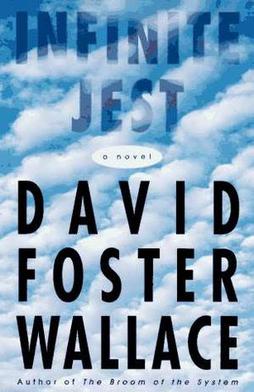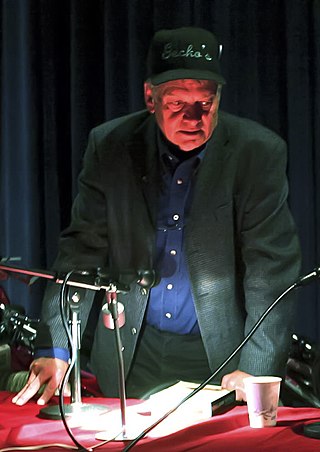The Absolute Infinite is an extension of the idea of infinity proposed by mathematician Georg Cantor.

Georg Ferdinand Ludwig Philipp Cantor was a mathematician who played a pivotal role in the creation of set theory, which has become a fundamental theory in mathematics. Cantor established the importance of one-to-one correspondence between the members of two sets, defined infinite and well-ordered sets, and proved that the real numbers are more numerous than the natural numbers. Cantor's method of proof of this theorem implies the existence of an infinity of infinities. He defined the cardinal and ordinal numbers and their arithmetic. Cantor's work is of great philosophical interest, a fact he was well aware of.

David Foster Wallace was an American novelist, short story writer, essayist, and university professor of English and creative writing. Wallace's 1996 novel Infinite Jest was cited by Time magazine as one of the 100 best English-language novels from 1923 to 2005. His posthumous novel, The Pale King (2011), was a finalist for the Pulitzer Prize for Fiction in 2012. The Los Angeles Times's David Ulin called Wallace "one of the most influential and innovative writers of the last twenty years".

Rudolf von Bitter Rucker is an American mathematician, computer scientist, science fiction author, and one of the founders of the cyberpunk literary movement. The author of both fiction and non-fiction, he is best known for the novels in the Ware Tetralogy, the first two of which both won Philip K. Dick Awards. Until its closure in 2014 he edited the science fiction webzine Flurb.

Infinite Jest is a 1996 novel by American writer David Foster Wallace. Categorized as an encyclopedic novel, Infinite Jest is featured in Time magazine's list of the 100 best English-language novels published between 1923 and 2005.

Terry Ballantine Bisson was an American science fiction and fantasy author. He was best known for his short stories, including "Bears Discover Fire", which won the Hugo Award and the Nebula Award, and "They're Made Out of Meat".
Paul Mavrides is an American artist, best known for his critique-laden comics, cartoons, paintings, graphics, performances and writings that encompass a disturbing yet humorous catalog of the social ills and shortcomings of human civilization. Mavrides worked with underground comix pioneer Gilbert Shelton on The Fabulous Furry Freak Brothers from 1978 to 1992. Mavrides has been noted for "adding new dimensions to the political comic" in the underground comix press of the 1970s and '80s.

White Light is a work of science fiction by Rudy Rucker published in 1980 by Virgin Books in the UK and Ace Books in the US. It was written while Rucker was teaching mathematics at the University of Heidelberg from 1978 to 1980, at roughly the same time he was working on the non-fiction book Infinity and the Mind.
The infinity symbol is a mathematical symbol representing the concept of infinity. This symbol is also called a lemniscate, after the lemniscate curves of a similar shape studied in algebraic geometry, or "lazy eight", in the terminology of livestock branding.
Popular mathematics is mathematical presentation aimed at a general audience. Sometimes this is in the form of books which require no mathematical background and in other cases it is in the form of expository articles written by professional mathematicians to reach out to others working in different areas.

In the sport of Australian rules football, each of the eighteen players in a team is assigned to a particular named position on the field of play. These positions describe both the player's main role and by implication their location on the ground. As the game has evolved, tactics and team formations have changed, and the names of the positions and the duties involved have evolved too. There are 18 positions in Australian rules football, not including four interchange players who may replace another player on the ground at any time during play.
John Phillips was the Anglican Bishop of Sodor and Man between 1604 and 1633. He is best known for writing the first dateable text in the Manx language in his translation of the 1604 Book of Common Prayer in 1610.

Infinity is something which is boundless, endless, or larger than any natural number. It is often denoted by the infinity symbol .

Infinity and the Mind: The Science and Philosophy of the Infinite is a popular mathematics book by American mathematician, computer scientist, and science fiction writer Rudy Rucker.

The Pale King is an unfinished novel by David Foster Wallace, published posthumously on April 15, 2011. It was planned as Wallace's third novel, and the first since Infinite Jest in 1996, but it was not completed at the time of his death. Before his suicide in 2008, Wallace organized the manuscript and associated computer files in a place where they would be found by his widow, Karen Green, and his agent, Bonnie Nadell. That material was compiled by his friend and editor Michael Pietsch into the form that was eventually published. Wallace had been working on the novel for over a decade. Even incomplete, The Pale King is a long work, with 50 chapters of varying length totaling over 500 pages.

Charleston, SC 1966 is the third studio album and the second country album from American recording artist Darius Rucker. It was released in the United States on October 12, 2010, through Capitol Nashville.

David Foster Wallace (1962–2008) was an American author of novels, essays, and short stories. In addition to writing, Wallace was employed as a professor at Illinois State University in Normal, Illinois, and Pomona College in Claremont, California.

The End of the Tour is a 2015 American drama film about writer David Foster Wallace. The film stars Jason Segel and Jesse Eisenberg, was written by Donald Margulies, and was directed by James Ponsoldt. Based on David Lipsky's best-selling memoir Although of Course You End Up Becoming Yourself, screenwriter Margulies first read the book in 2011, and sent it to Ponsoldt, a former student of his, who took on the job of director. Filming took place in early 2014 in Michigan, with scenes also shot at the Mall of America. Danny Elfman provided the score, with the soundtrack featuring songs by musicians like R.E.M. and Brian Eno, whose inclusion was based on the kind of music Wallace and Lipsky listened to.












